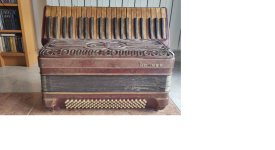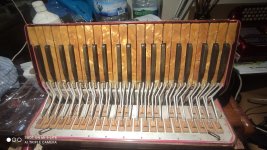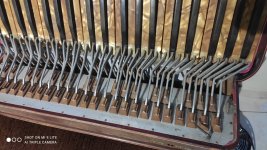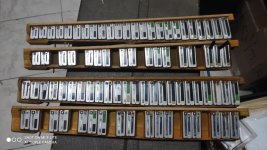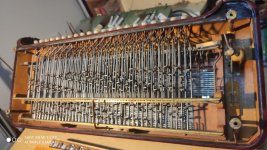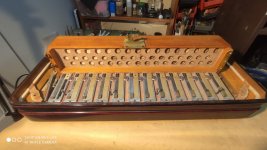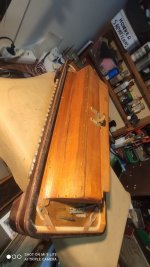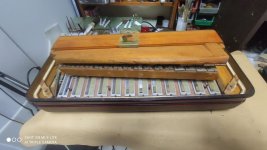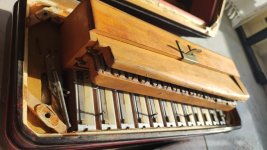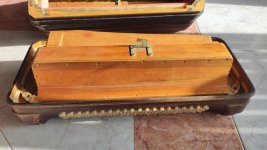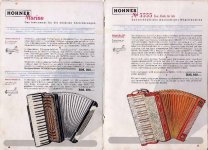D
You are using an out of date browser. It may not display this or other websites correctly.
You should upgrade or use an alternative browser.
You should upgrade or use an alternative browser.
Hohner morino 5555s ? convertor ? free bas in cassotto ?
Vladimir M.
Active member
Hi Musacord,
wau, what a beautiful instrument. Congratulations! How many notes has the instrument in the free bass? Does the converter switch three rows of buttons or even four? Anyway, it's a rare piece.
Best regards, Vladimir
wau, what a beautiful instrument. Congratulations! How many notes has the instrument in the free bass? Does the converter switch three rows of buttons or even four? Anyway, it's a rare piece.
Best regards, Vladimir
Dingo40
Been here for ages!
Gorgeous!

D
Deleted member 2438
Guest
Thread starter
Hello! I still haven't checked how many free bas queues there are. As soon as I check, I will reply.Hi Musacord,
wau, what a beautiful instrument. Congratulations! How many notes has the instrument in the free bass? Does the converter switch three rows of buttons or even four? Anyway, it's a rare piece.
Best regards, Vladimir
D
Deleted member 2438
Guest
Thread starter
D
Deleted member 2438
Guest
Thread starter
What I found on the net about the first Morino.
Very interesting construction inside this Morino. You can see from the pictures that this accordion actually takes a lot of manual (woodworking) labour to construct. Only these older ones have such laborious construction. With the Morino M only the lowest bass reeds still got a cassotto-like chamber, a per-note chamber called "Umlenkstimmstock", similar to the "Winkelbaß" but with 180 degree angle instead of 90 degrees.
Over the decades Hohner was looking for more and more cost savings by simplifying the construction, eventually reaching the cheapest possible construction with the "Metalbau" in the Atlantic and other models (Lucia, Pirola, Imperator)... reducing the amount of manual woodworking to a strict minimum. So in some sense this old Morino is a rare "gem", a labour of love. But... it requires a lot more labour of love to bring it back to a pristine state...
Over the decades Hohner was looking for more and more cost savings by simplifying the construction, eventually reaching the cheapest possible construction with the "Metalbau" in the Atlantic and other models (Lucia, Pirola, Imperator)... reducing the amount of manual woodworking to a strict minimum. So in some sense this old Morino is a rare "gem", a labour of love. But... it requires a lot more labour of love to bring it back to a pristine state...
I don't think this is free bass. Definitely not a converter, though. There were some with "bariton bass" buttons (2 rows of chromatic bass), which is like an early form of MIII free bass (i.e. separate buttons, not converter). But as far as I know those 2 rows were additional rows, so you would then have 8 rows of bass buttons.
This is the same construction I have in my 1953 Morino IV M, except mine omits the high bass reedblock.
When you deconstruct this thing the bass half itself is pretty bare:
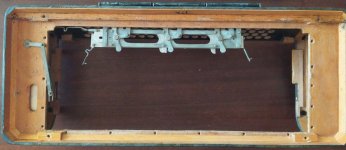
The bass box thing comes out as a unit:
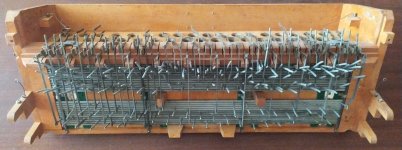
And this is a look at the opposite side of where the reedblocks sit:
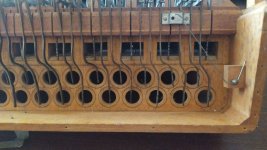
This is the same construction I have in my 1953 Morino IV M, except mine omits the high bass reedblock.
When you deconstruct this thing the bass half itself is pretty bare:

The bass box thing comes out as a unit:

And this is a look at the opposite side of where the reedblocks sit:

The Morinos with converters from the pre-M era typically have the same internal bass layout as the (non-converter) Morino VI M free bass. The lowest 2 octaves sit on a single tall but sunken reed block, and the others are split over 3 blocks.
See for example:
See for example:
D
Deleted member 2438
Guest
Thread starter
Mechanically, functionally the accordion is in good condition, all original voices, little rust. The only thing to regret is the aesthetics...the celluloid...
D
Deleted member 2438
Guest
Thread starter
In the last photo... the place of the sneakers is marked, as well as the Atlantic, Lucia, Pirola, Imperator...etc..I don't think this is free bass. Definitely not a converter, though. There were some with "bariton bass" buttons (2 rows of chromatic bass), which is like an early form of MIII free bass (i.e. separate buttons, not converter). But as far as I know those 2 rows were additional rows, so you would then have 8 rows of bass buttons.
This is the same construction I have in my 1953 Morino IV M, except mine omits the high bass reedblock.
When you deconstruct this thing the bass half itself is pretty bare:
The bass box thing comes out as a unit:
And this is a look at the opposite side of where the reedblocks sit:

There are no sneakers in an accordion. What do you mean by sneakers (which are normally some type of sports shoe)? Maybe the pallets?In the last photo... the place of the sneakers is marked, as well as the Atlantic, Lucia, Pirola, Imperator...etc..
Vladimir M.
Active member
Hi,
The instrument was probably overhauled about a few decades ago, during which the reed plates received new plastic valves. During their service life, some damaged and worn plastic valves were replaced. There are many missing valves in the discant (yellow arrows) or beyond the service life limit (green arrows).
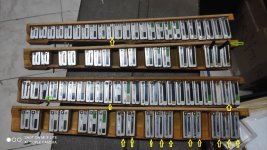
Photos of the bass reed blocks are not available, nor are detailed photos of the condition of wax. Therefore, I do not believe that:
It is necessary to tear off all reed plates from the reed-blocks, then thoroughly clean them in a technical solution and clean (or repair) also the wooden reed blocks. Subsequently, new valves are attached to the plates, and waxing and pre-tuning are performed. Then clean tuning inside the instrument. The bellows definitely needs to be fixed as well. It also might be worth renewing the felt on the flaps.
Faded celluloid is really just the last flaw that would bother me when playing such a historical instrument.
Best regards, Vladimir
The instrument was probably overhauled about a few decades ago, during which the reed plates received new plastic valves. During their service life, some damaged and worn plastic valves were replaced. There are many missing valves in the discant (yellow arrows) or beyond the service life limit (green arrows).

Photos of the bass reed blocks are not available, nor are detailed photos of the condition of wax. Therefore, I do not believe that:
...functionally the accordion is in good condition...
It is necessary to tear off all reed plates from the reed-blocks, then thoroughly clean them in a technical solution and clean (or repair) also the wooden reed blocks. Subsequently, new valves are attached to the plates, and waxing and pre-tuning are performed. Then clean tuning inside the instrument. The bellows definitely needs to be fixed as well. It also might be worth renewing the felt on the flaps.
The only thing to regret is the aesthetics...the celluloid...
Faded celluloid is really just the last flaw that would bother me when playing such a historical instrument.
Best regards, Vladimir
D
Deleted member 2438
Guest
Thread starter
Functional, I want to say, that mechanically it's working... but of course it's out of tune...Hi,
The instrument was probably overhauled about a few decades ago, during which the reed plates received new plastic valves. During their service life, some damaged and worn plastic valves were replaced. There are many missing valves in the discant (yellow arrows) or beyond the service life limit (green arrows).
Photos of the bass reed blocks are not available, nor are detailed photos of the condition of wax. Therefore, I do not believe that:
It is necessary to tear off all reed plates from the reed-blocks, then thoroughly clean them in a technical solution and clean (or repair) also the wooden reed blocks. Subsequently, new valves are attached to the plates, and waxing and pre-tuning are performed. Then clean tuning inside the instrument. The bellows definitely needs to be fixed as well. It also might be worth renewing the felt on the flaps.
Faded celluloid is really just the last flaw that would bother me when playing such a historical instrument.
Best regards, Vladimir
I have a proven soft spot for Horner's in my heart and I think this one is lovely and feel it worthy of a nice complete service... if not a full restore, but that accordion is not Free Bass. It's a 120 bass (no extra rows) and no switch anywhere for it to move in to "converter mode".
Vladimir M.
Active member
Functional, I want to say, that mechanically it's working...
The fact that the treble and especially the bass mechanics are fine is good news. Yes, it is a beautiful instrument that is worth to be restored. If the mechanics are in order and the reeds are (as seen on photos) preserved and without corrosion, the costs will not be so high. On the other hand, I would avoid today's modern purism, which strictly tries to restore instruments to their original condition. In this case, we do not have to return to the original leather valves, as they were used in the first half of the 20th century. I think that plastic valves can also be used. I have those in my instrument and I'm happy with them. Similar to the case of building reconstruction here in Europe: If you are renovating e.g. Gothic building, so you will also keep the Renaissance extensions. Likewise here: a good craftsman can put an instrument in excellent technical condition using current technologies. I'm keeping my fingers crossed that the restoration of the instrument will be successful.this one is lovely and feel it worthy of a nice complete service...
Best regards, Vladimir
D
Deleted member 2438
Guest
Thread starter
I'm the one who's going to do the restoration, I'm a technician and a tuner.... but if someone comes along who wants to buy it - I'd sell it before...The fact that the treble and especially the bass mechanics are fine is good news. Yes, it is a beautiful instrument that is worth to be restored. If the mechanics are in order and the reeds are (as seen on photos) preserved and without corrosion, the costs will not be so high. On the other hand, I would avoid today's modern purism, which strictly tries to restore instruments to their original condition. In this case, we do not have to return to the original leather valves, as they were used in the first half of the 20th century. I think that plastic valves can also be used. I have those in my instrument and I'm happy with them. Similar to the case of building reconstruction here in Europe: If you are renovating e.g. Gothic building, so you will also keep the Renaissance extensions. Likewise here: a good craftsman can put an instrument in excellent technical condition using current technologies. I'm keeping my fingers crossed that the restoration of the instrument will be successful.
Best regards, Vladimir
Plastic Valves is a very good invention, it has many positive parts:
-longevity, 30 years and more...
-increase tuning accuracy
- stability : keep the tuning ...for decades..
.... the Hohners that come with plastic valves... if it doesn't have rust, the tuning doesn't change much...
The Italians waited a long time... to see how plastic valves behave.... nowadays... even the most expensive accordions have plastic valves like Pigini Nova, Sirius.....etc. ..
D
Deleted member 2438
Guest
Thread starter
yes, I meant pallets... it's Google's fault, he translated it like this..lolThere are no sneakers in an accordion. What do you mean by sneakers (which are normally some type of sports shoe)? Maybe the pallets?
Similar threads
- Replies
- 21
- Views
- 474
- Replies
- 11
- Views
- 738
- Replies
- 3
- Views
- 1,692

